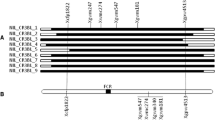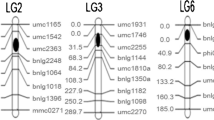Abstract
A molecular marker map, including Mlo mildew resistance, of the spring barley cross Derkado (Mlo-resistant) × B83-12/21/5 (Mlo-susceptible) was scanned for yield QTLs to determine whether the association of Mlo resistance with reduced yield was due to linkage or pleiotropy. Over the mapped portion of the genome of the cross, the QTL with the greatest effect upon yield was located within a 22 cM region between mlo and the simple sequence repeat HVM67 on chromosome 4(4H). The association of Mlo resistance with lower yield was therefore due to a repulsion linkage. Analysis of yield component characters revealed QTL alleles for reduced grain number and earlier heading date in the same region, also associated with Mlo resistance. Genotyping of a range of cultivars and sources of Mlo resistance with the HVM67 simple sequence repeat showed that the Derkado HVM67 allele was rare as it was found only in one other cultivar and four land-races or sources of disease resistance. Grannenlose Zweizeilige, the source, and Salome, the carrier of Mlo resistance in Derkado, have the same HVM67 genotype, although Salome was a mixture of two genotypes. The entire mlo-HVM67 chromosomal segment from Grannenlose Zweizeilige is therefore thought to have been transmitted to Derkado, possibly through joint selection for Mlo resistance and early heading. L92, synonym EP79, was another source of Mlo resistance with the same HVM67 allele as Derkado but recombination must have occurred during the breeding of Atem as it possesses a different HVM67 allele which is present in all the other Mlo sources and cultivars surveyed. Abbreviations: GN, grains per main stem ear; HD, heading date; MSTGW, thousand grain weight derived from GN and MSY; MSY, yield of grain on the main stem; PY, yield of grain from the whole plot; sCIM, simplified compound interval mapping; SIM, simple interval mapping; SPY, single plant yield; S-SAP, sequence-specific amplification polymorphism; TGW, thousand grain weight derived from bulk of plot seed; TN, number of fertile stems per plant.
Similar content being viewed by others
References
Agricultural Supply Industry: Harvest Review, Agricultural Supply Industry special supplement, autumn 1996. PJB Publications, Richmond (1996).
Ali MAM, Okiror SO, Rasmusson DC: Performance of semi-dwarf barley. Crop Sci 18: 418–422 (1978).
Backes G, Graner A, Foroughi-Wehr B, Fischbeck G, Wenzel G, Jahoor A: Localisation of quantitative trait loci (QTL) for agronomic important characters by the use of a RFLP map in barley (Hordeum vulgare L.). Theor Appl Genet 90: 294–302 (1995).
Barua UM, Chalmers KJ, Thomas WTB, Hackett CA, Lea V, Jack P, Forster BP, Waugh R, Powell W: Molecular mapping of genes determining height, time to heading and growth habit in barley (Hordeum vulgare). Genome 36: 1080–1087 (1993).
Becker J, Heun M: Barley microsatellites: allele variation and mapping. Plant Mol Biol 27: 835–845 (1995).
Bezant J, Laurie D, Pratchett N, Chojecki J, Kearsey M: Mapping QTL controlling yield and yield components in a spring barley (Hordeum vulgare L.) cross using marker regression. Mol Breed 3: 29–38 (1997).
Bjornstad A, Aastveit K: Pleiotropic effect on the ml-o mildew resistance gene in barley in different genetical backgrounds. Euphytica 46: 217–226 (1990).
Buschges R, Hollricher K, Panstruga R, Simons G, Wolter M, Frijters A, van Daelan R, van der Lee T, Diergaarde P, Groenendijk J, Topsch S, Vos P, Salamini F, Schulze-Lefert P: The barley Mlo gene: a novel control element of plant pathogen resistance. Cell 88: 695–705 (1997).
Dyck PL: Genetics of adult-plant, leaf rust resistance in ‘Chinese Spring’ and ‘sturdy’ wheats. Crop Sci 31: 309–311 (1991).
Ellis RP, McNicol JW, Baird E, Booth A, Lawrence P, Thomas WTB, Powell W: The use of AFLPs to examine genetic relatedness in barley. Mol Breed 3: 359–369 (1997).
Finnie SJ, Powell W, Dyer AF: The effect of carbohydrate composition and concentration on anther culture response in barley (Hordeum vulgare L.). Plant Breed 103: 110–118 (1989).
Fischbeck G: Barley cultivar development in Europe – success in the past and possible changes in the future. In: Munck L (ed) Barley Genetics VI (II) Proceedings of the sixth International Barley Genetics Symposium, Helsingborg, Sweden, 1991, pp. 885–901. Munksgaard, Copenhagen (1992).
Franckowiak JD: Allelism tests among selected semidwarf barleys. 1991 Barley Genet Newsl 21: 17–23 (1992).
Franckowiak JD: Coordinators report: Semidwarf genes. 1995 Barley Genet Newsl 25: 112 (1996).
Genstat 5 Committee: GenstatTM 5 release 3 reference manual. Clarendon Press, Oxford (1993).
Hayes PM, Liu BH, Knapp SJ, Chen F, Jones B, Blake T, Franckowiak J, Rasmusson D, Sorrells M, Ullrich SE, Wesenberg D, Kleinhofs A: Quantitative trait locus effects and environmental interaction in a sample of North-American barley germ plasm. Theor Appl Genet 87: 392–401 (1993).
Hinze K, Thompson RD, Ritter E, Salamini F, Schulze-Lefert P: Restriction fragment length polymorphism-mediated targeting of the ml-o resistance locus in barley (Hordeum vulgare). Proc Natl Acad Sci USA 88: 3691–3695 (1991).
Jorgensen JH: Discovery, characterisation and exploitation of Mlo powdery mildew resistance in barley. Euphytica 63: 141–152 (1992).
Kjaer B, Jensen J: Quantitative trait loci for grain yield and yield components in a cross between a six-rowed and a two-rowed barley. Euphytica 90: 39–49 (1996).
Kjaer B, Jensen HP, Jensen J, Jorgensen JH: Associations between three ml-o powdery mildew resistance genes and agronomic traits in barley. Euphytica 46: 185–193 (1990).
Langridge P, Karakousis A, Collins N, Kretschmer J, Manning S: A consensus linkage map of barley. Mol Breed 1: 389–395 (1995).
Laurie DA, Pratchett N, Bezant JH, Snape JW: RFLP mapping of five major genes and eight quantitative trait loci controlling flowering time in a winter × spring barley (Hordeum vulgare L.) cross. Genome 38: 575–585 (1995).
Laurie DA, Pratchett N, Romero C, Simpson E, Snape JW: Assignment of the denso dwarfing gene to the long arm of chromosome 3(3H) of barley by use of RFLP markers. Plant Breed 111: 198–203 (1993).
Liu Z-W, Biyashev RM, Saghai-Maroof MA: Development of simple sequence repeat DNA markers and their integration into a barley linkage map. Theor Appl Genet 93: 869–876 (1996).
Manninen OM, Turpeinen T, Nissila E: Identification of RAPD markers closely linked to the mlo-locus in barley. Plant Breed 116: 461–464 (1997).
McCouch SR, Chen X, Panaud O, Temnykh S, Xu Y, Cho YG, Huang N, Ishii T, Blair M: Microsatellite marker development, mapping and applications in rice genetics and breeding. Plant Mol Biol 35: 89–99 (1997).
Ministry of Agriculture Fisheries and Food: Plant varieties and seeds gazette number 239, December 1984, p. 22. MAFF/Plant Variety Rights Office, Cambridge, UK (1994).
National Institute of Agricultural Botany: 1997 NIAB recommended lists of cereals: cereal variety handbook. National Institute of Agricultural Botany, Cambridge, UK (1997).
Pakniyat H, Baird E, Thomas WTB, Caligari PDS, Powell W, Forster BP: Effect of semi-dwarf mutants on salt tolerance in barley. In: Slinkard AE, Scoles GJ, Rossnagel BG (eds) Proceedings of Fifth International Oat Conference & Seventh International Barley Genetics Symposium, Saskatoon 1996, pp. 660–661. University of Saskatchewan, Saskatoon (1996).
Paterson AH, Damon S, Hewitt JD, Zamir D, Rabinowitch HD, Lincoln SE, Lander ES, Tanksley SD: Mendelian factors underlying quantitative traits in tomato: comparison across species generations and environments. Genetics 127: 181–197 (1991).
Powell W, Machray GC, Provan J: Polymorphism revealed by simple sequence repeats. Trends Plant Sci 1: 215–222 (1996).
Powell W, Morgante M, Andre C, Hanafey M, Vogel J, Tingey S, Rafalski A: The utility of RFLP, RAPD, AFLP and SSR (microsatellite) markers for germplasm analysis. Mol Breed 2: 225–238 (1996).
Powell W, Thomas WTB, Baird E, Lawrence P, Booth A, Harrower B, McNicol JW, Waugh R: Analysis of quantitative traits in barley by the use of amplified fragment length polymorphisms. Heredity 79: 49–59 (1997).
Qi X, Stam P, Lindhout P: Comparison and integration of four barley genetic maps. Genome 39: 379–394 (1996).
Russell G, Ellis RP, Brown J, Milbourn GM, Hayter AM: The development of autumn-and spring-sown barley in south east Scotland. Ann Appl Biol 100: 167–178 (1982).
Russell J, Fuller J, Young G, Thomas W, Taramino G, Macaulay M, Waugh R, Powell W: Discriminating between barley genotypes using microsatellite markers. Genome 40: 442–450 (1997).
Saghai-Maroof MA, Biyashev RB, Yang GP, Zhang Q, Allard RW: Extraordinarily polymorphic microsatellite DNA in barley: species diversity, chromosomal locations, and population dynamics. Proc Natl Acad Sci USA 81: 5466–5470 (1994).
Schwarzbach E: The pleiotropic effects of the ml-o gene and their implications in breeding. In: Gaul H (ed) Barley Genetics III, Proceedings of the third International Barley Genetics Symposium, Munich 1995, pp. 440–445. Verlag Karl Thiemig, München (1976).
Singh RP, Huerta-Espino J: Effect of leaf rust gene Lr34 on grain yield and agronomic traits of spring wheats. Crop Sci 37: 390–395 (1997).
Snape JW, Simpson E: The genetical expectation of doubled haploid lines derived from different filial generations. Theor Appl Genet 60: 123–128 (1981).
Snape JW, Simpson E: Uses of doubled haploid lines for genetical analysis in barley. In: Asher MJC, Ellis RP, Hayter AM, Whitehouse RNH (eds) Barley Genetics IV, Proceedings of the fourth International Barley Genetics Symposium, Edinburgh 1981, pp. 704–709. Edinburgh University Press, Edinburgh (1981).
Sogaard B, von Wettstein-Knowles P: Barley: genes and chromosomes. Carlsberg Res Commun 52: 123–196 (1987).
Stam P, van Ooijen JW: JoinmapTM version 2.0: Software for the calculation of genetic linkage maps. CPRO-DLO, Wageningen, Netherlands (1995).
Swanston JS: The consequences, for malting quality, of Hordeum laevigatum as a source of mildew resistance in barley breeding. Ann Appl Biol 110: 351–355 (1987).
Thomas WTB, Powell W, Swanston JS, Forster BP: The association between the linked loci ml-o, Bmy1 and Wsp3 and quantitative characters in barley. Vort Pflanzenzucht 20: 255–260 (1991).
Thomas WTB, Powell W, Waugh R, Chalmers KJ, Barua UM, Jack P, Lea V, Forster BP, Swanston JS, Ellis RP, Hanson PR, Lance RCM: Detection of quantitative trait loci for agronomic, yield, grain and disease characters in spring barley. Theor Appl Genet 91: 1037–1047 (1995).
Tinker NA, Mather DE: Methods for QTL analysis in progeny replicated in multiple environments.J Quant Trait Loci, http://probe.nalusda.gov:8000/otherdocs/jqtl/jqtl1995-01/jqtl15.html (1995).
Tinker NA, Mather DE: MQTL: software for simplified composite interval mapping of QTL in multiple environments.J Quant Trait Loci, http://probe.nalusda.gov:8000/otherdocs/jqtl/jqtl1995-02/jqtl16r2.html (1995).
Tinker NA, Mather DE, Rossnagel BG, Kasha KJ, Kleinhofs A, Hayes PM, Falk DE, Ferguson T, Shugar LP, Legge WG, Irvine RB, Choo TM, Briggs KG, Ullrich SE, Franckowiak JD, Blake TK, Graf RJ, Dofing SM, Saghai-Maroof MA, Scoles GJ, Hoffman D, Dahleen LS, Kilian A, Chen F, Biyashev RM, Kudrna DA, Steffenson BJ: Regions of the genome that affect agronomic performance in two-row barley. Crop Sci 36: 1053–1062 (1996).
Tottman DR: The decimal code for the growth stages of cereals with illustrations. Ann Appl Biol 110: 441–454 (1987).
Waugh R, McLean K, Flavell AJ, Pearce SR, Kumar A, Thomas WTB, Powell W: Genetic distribution of Bare-1-like retrotransposable elements in the barley genome revealed by sequence-specific amplification polymorphisms (S-SAP). Mol Gen Genet 253: 687–694 (1997).
Waugh R, Macaulay M, McLean K, Fuller J, Bonar N, Ramsay L, Powell W: Development of a simple sequence repeat-based linkage map of barley. In: Annual Report of the Scottish Crop Research Institute for 1996/7, pp. 82–84. Scottish Crop Research Institute, Dundee, UK (1997).
Author information
Authors and Affiliations
Rights and permissions
About this article
Cite this article
Thomas, W., Baird, E., Fuller, J. et al. Identification of a QTL decreasing yield in barley linked to Mlo powdery mildew resistance. Molecular Breeding 4, 381–393 (1998). https://doi.org/10.1023/A:1009646115967
Issue Date:
DOI: https://doi.org/10.1023/A:1009646115967




